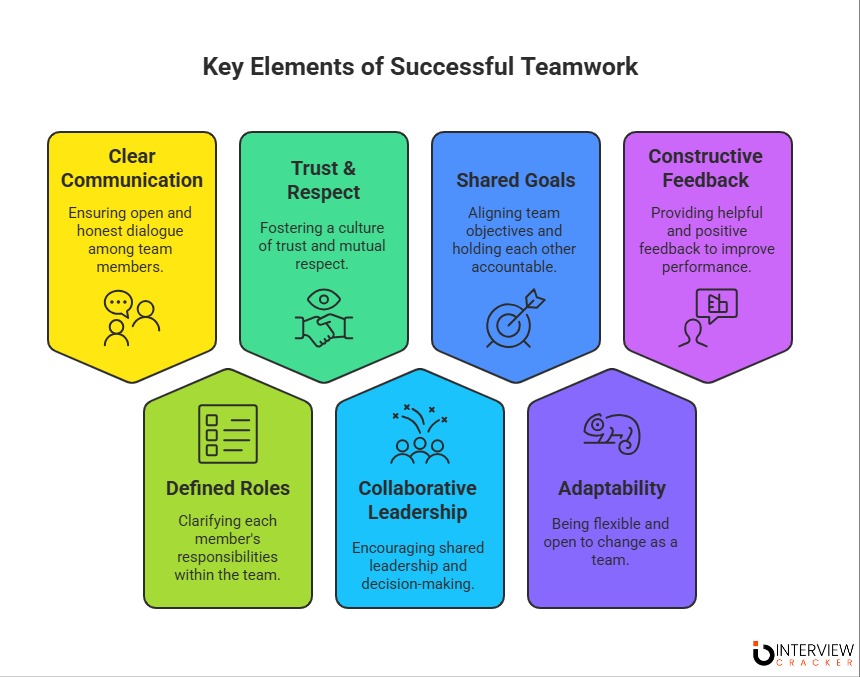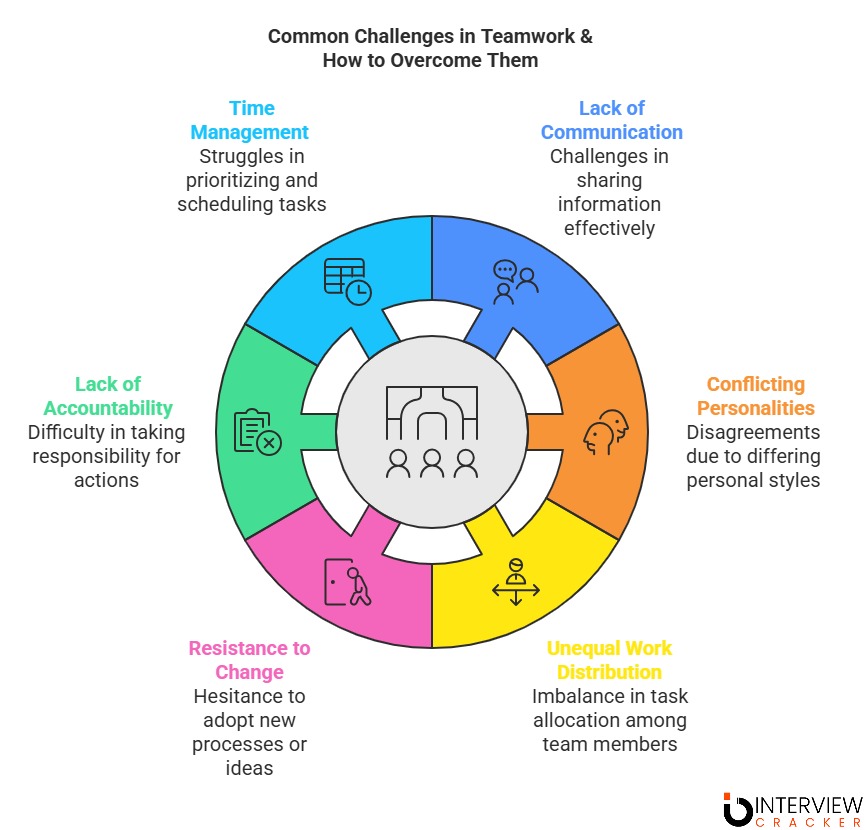Teamwork and collaboration are essential elements that drive success in today’s dynamic business landscape. Organizations worldwide are recognizing the transformative potential of effective teamwork and collaboration in achieving their goals. In this article, we delve into the secrets behind fostering a culture of teamwork and collaboration within your organization and explore how it can propel your team towards greater heights of achievement.
Table of Contents
ToggleWhat is Teamwork and Collaboration? | Define Team Collaboration
Team collaboration is more than just working together; it’s about leveraging collective expertise and resources to achieve common goals. By definition, team collaboration involves individuals pooling their talents, skills, and insights to drive innovation, problem-solving, and decision-making. Understanding the core principles of team collaboration empowers teams to harness its full potential and achieve greater synergy in their endeavors.
The Science Behind Effective Teamwork
Effective teamwork is rooted in psychology and behavioral science. Studies show that well-functioning teams exhibit high levels of trust, communication, and interdependence. The concept of social interdependence theory suggests that when individuals perceive their success as linked to others, they work collaboratively towards a shared goal. Psychological safety, a term coined by Harvard Professor Amy Edmondson, is another key factor that enables team members to express ideas and take risks without fear of negative consequences.
Additionally, neuroscience reveals that teamwork activates the brain’s reward system, releasing dopamine and oxytocin, which enhance motivation and bonding. This fosters a positive team environment, boosting creativity and overall performance.
Key Elements of Successful Teamwork

Clear Communication – Open, honest, and effective communication ensures that all team members understand their roles and responsibilities.
Defined Roles & Responsibilities – Clarity in roles prevents misunderstandings and enhances efficiency.
Trust & Mutual Respect – A foundation of trust enables team members to rely on one another, fostering a positive working relationship.
Collaborative Leadership – Leaders should encourage participation and ensure every voice is heard.
Shared Goals & Accountability – Teams must work towards common objectives while holding each other accountable for results.
Adaptability & Flexibility – Successful teams embrace change and adjust strategies as needed.
Constructive Feedback – Regular feedback helps individuals improve and aligns efforts with team goals.
Benefits of Teamwork and Collaboration
Teamwork and collaboration are essential for success in any environment, whether at work, school, or in social settings. Here are some key benefits of working together effectively:
1. Increased Productivity
When individuals collaborate, tasks are divided based on skills and strengths, making work more efficient. Teams can accomplish more in less time compared to individuals working alone.
2. Enhanced Creativity and Innovation
Collaboration encourages brainstorming and idea-sharing, leading to innovative solutions. Different perspectives bring fresh ideas, which helps businesses and organizations stay ahead in competitive markets.
3. Improved Problem-Solving
A team can analyze a problem from multiple angles and find solutions faster than an individual. The combined expertise and experience of a group often lead to more effective decision-making.
4. Stronger Employee Engagement and Satisfaction
People who work in a collaborative environment feel more valued and motivated. Teamwork fosters a sense of belonging, reduces workplace stress, and boosts overall job satisfaction.
5. Better Communication and Interpersonal Skills
Teamwork requires active listening, clear communication, and constructive feedback. Working with others improves these skills, leading to stronger relationships in both professional and personal life.
6. Faster Learning and Skill Development
Collaboration allows team members to learn from each other’s experiences, speeding up skill development. New employees, for example, can quickly adapt when working with experienced colleagues.
7. Builds Trust and Team Bonding
When people work together toward a common goal, they build trust and form stronger relationships. A well-bonded team performs better and is more resilient in challenging situations.
8. Increased Adaptability
In dynamic industries, teamwork enables organizations to adapt quickly to changes. When teams work together, they can pivot strategies and implement solutions more effectively.
9. Higher Efficiency and Reduced Workload Stress
Shared responsibilities lighten the workload for individuals, reducing stress and burnout. A collaborative environment ensures that no one feels overwhelmed with too much work.
10. Achieving Common Goals Successfully
A well-coordinated team can achieve bigger goals that would be impossible for a single person. Whether launching a product, managing a project, or organizing an event, teamwork ensures smooth execution and success.
Teamwork and Collaboration Examples
Teamwork and collaboration are essential in various aspects of life, from workplaces to sports teams and even community projects. Below are some real-world examples that showcase the power of working together effectively.
1. Workplace Collaboration: A Marketing Campaign
A company launching a new product requires seamless collaboration between different departments. The marketing team creates the campaign strategy, the design team works on visuals, the content team writes engaging messages, and the sales team ensures proper execution. When all teams work together, the campaign becomes a success, boosting brand awareness and revenue.
2. Healthcare Teamwork: Patient Care
In hospitals, doctors, nurses, and specialists collaborate to provide the best patient care. For example, during surgery, a surgeon, anesthesiologist, and nurses must communicate and coordinate efficiently. This teamwork ensures patient safety and a successful procedure.
3. Sports Team Coordination: A Football Match
A football team relies on coordination between players, coaches, and support staff. A striker cannot score goals without accurate passes from midfielders, and defenders need to work with the goalkeeper to protect their net. Teams that practice effective communication and strategy often outperform their opponents.
4. Remote Team Collaboration: A Software Development Project
With remote work becoming more common, tech teams often collaborate from different locations. A software project involves developers writing code, UI/UX designers crafting user-friendly interfaces, and project managers ensuring deadlines are met. Using collaboration tools like Slack, Trello, or Zoom helps maintain smooth workflows despite the distance.
5. Community Collaboration: Organizing a Charity Event
A group of volunteers coming together to organize a charity fundraiser is a great example of teamwork. Some people handle logistics, others focus on fundraising, while some manage marketing and event promotion. Their collective effort results in a successful event that supports a good cause.
Collaboration in the Digital Era
The rise of remote work and digital transformation has redefined teamwork. Team collaboration in today’s digital age extends beyond traditional boundaries. With the advent of online collaboration tools and platforms, teams can seamlessly connect and collaborate irrespective of geographical constraints. Embracing digital platforms facilitates real-time communication, document sharing, and project management, fostering a cohesive team environment regardless of physical location.
Today’s teams collaborate across geographical boundaries using various digital tools:
Communication Tools: Slack, Microsoft Teams, and Zoom facilitate seamless conversations.
Project Management Tools: Trello, Asana, and Monday.com help track progress and responsibilities.
Cloud Collaboration: Google Drive and Dropbox allow teams to work on shared documents in real time.
AI-powered Assistance: AI-driven tools like Notion AI and ChatGPT enhance efficiency and automation in collaborative work.
While digital collaboration offers flexibility, it also presents challenges such as miscommunication, time zone differences, and lack of personal interaction. To counter these, companies need to establish clear digital communication norms and encourage virtual team-building activities.
Suggested Read: What is Remote work?
Best Tools for Collaboration and Teamwork
Collaboration tools help teams communicate, manage projects, and work efficiently, whether they are in the same office or spread across different locations. Here are some of the best tools for teamwork and collaboration:
1. Communication Tools
Slack – A messaging app that allows teams to communicate in channels, share files, and integrate with other tools.
Microsoft Teams – A professional chat and video conferencing tool with document-sharing features.
Zoom – Popular for video meetings, webinars, and virtual team discussions.
Google Meet – A simple and secure video conferencing solution integrated with Google Workspace.
2. Project Management Tools
Trello – A visual task management tool that uses boards, lists, and cards to organize projects.
Asana – A task and project tracking tool that helps teams plan and coordinate work.
Monday.com – A highly customizable work management platform for tracking tasks and projects.
ClickUp – A flexible project management tool with task assignments, time tracking, and integrations.
3. Document Collaboration Tools
Google Workspace (Docs, Sheets, Slides) – Allows real-time collaboration on documents, spreadsheets, and presentations.
Microsoft 365 (Word, Excel, PowerPoint) – Provides cloud-based file sharing and editing features.
Notion – A versatile tool for team documentation, notes, and databases.
Dropbox Paper – A collaborative document-editing tool with integration capabilities.
4. File Sharing and Storage
Google Drive – Cloud storage for documents, images, and files with easy sharing options.
Dropbox – A file storage and sharing platform with collaboration features.
OneDrive – Microsoft’s cloud storage solution for personal and team file sharing.
5. Time Management and Productivity Tools
Toggl Track – A simple time tracking tool for teams and freelancers.
RescueTime – Helps monitor time spent on tasks and boosts productivity.
Clockify – A free time-tracking tool with project management features.
6. Brainstorming and Whiteboarding Tools
Miro – An online collaborative whiteboard for brainstorming and idea mapping.
Lucidspark – A virtual whiteboard tool for team collaboration and creativity.
MindMeister – A mind-mapping tool to visually organize ideas.
7. Customer Relationship and Team Support Tools
HubSpot CRM – Helps teams manage customer relationships and communication.
Salesforce – A comprehensive CRM for sales, marketing, and service teams.
Zendesk – A tool for managing customer support and internal team collaboration.
The right collaboration tools can enhance teamwork, improve communication, and streamline workflows. Choosing the best tool depends on the team’s needs, whether for communication, project management, or document sharing.
Strategies to Improve Teamwork and Collaboration
Encourage Open Communication – Foster a culture where team members feel comfortable expressing their thoughts.
Foster Emotional Intelligence – Understanding and managing emotions helps improve teamwork.
Promote Cross-functional Collaboration – Teams with diverse skill sets drive innovation and problem-solving.
Leverage Team-building Exercises – Activities like brainstorming sessions and group challenges build stronger bonds.
Implement Regular Check-ins – Daily or weekly stand-up meetings keep the team aligned on progress.
Use Data-Driven Insights – Analytics on team performance can help refine strategies and identify areas for improvement.

Common Challenges in Teamwork & How to Overcome Them
Lack of Communication – Solution: Establish clear guidelines for communication and use collaboration tools effectively.
Conflicting Personalities – Solution: Encourage mutual respect and mediation to resolve differences.
Unequal Work Distribution – Solution: Set clear expectations and ensure fair workload distribution.
Resistance to Change – Solution: Provide training and support to help teams adapt to new processes.
Lack of Accountability – Solution: Implement performance tracking and provide constructive feedback.
Time Management Issues – Solution: Prioritize tasks using productivity frameworks like the Eisenhower Matrix.
The Future of Teamwork & Collaboration
With advancing technology and evolving work cultures, teamwork will continue to transform. Some key trends include:
AI & Automation in Collaboration: AI-powered assistants will streamline workflows, allowing teams to focus on high-value tasks.
Hybrid Work Models: A blend of remote and in-office collaboration will be the norm.
Increased Focus on Diversity & Inclusion: Companies will prioritize diverse teams to drive innovation.
Enhanced Virtual Reality (VR) Collaboration: VR-based workspaces will enable immersive teamwork experiences.
Organizations must adapt to these changes by investing in digital tools, fostering adaptability, and prioritizing employee well-being.
Actionable Tips for Individuals & Organizations
For Individuals:
Be a good listener and acknowledge others’ contributions.
Offer help and support to team members when needed.
Stay reliable and accountable for assigned tasks.
Cultivate a growth mindset and be open to feedback.
Be proactive in resolving conflicts and misunderstandings.
For Organizations:
Invest in team development programs and leadership training.
Create a positive workplace culture that encourages collaboration.
Use the latest collaboration tools to enhance productivity.
Regularly assess team performance and optimize processes.
Promote employee engagement initiatives to keep teams motivated.
By implementing these strategies, both individuals and organizations can master the art of teamwork and collaboration, leading to long-term success.
Conclusion
Unlocking the power of teamwork and collaboration is key to driving organizational success in today’s competitive landscape. By cultivating a collaborative environment, establishing clear goals, embracing diversity and inclusion, leveraging technology, nurturing trust and accountability, and encouraging continuous learning and development, organizations can foster a culture of collaboration that propels their teams towards excellence. Embrace the secrets of teamwork and collaboration, and watch your team soar to new heights of achievement.



